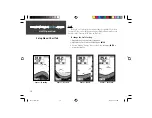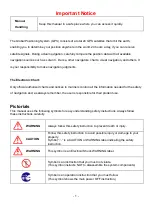
30
On the Water
On the Water
1
1
2
2
3
3
Understanding Sonar
If you are unfamiliar with sonar, or need help determining what is
displayed on the chart, then this section may be for you. This section
is intended to help the novice user gain some understanding of how the
Fishfinder 100 Blue operates and how it can help improve their fishing
productivity.
To understand what the unit is displaying, it is important to have a
general knowledge of how the unit works and how it determines what to
display. Briefly described, the unit operates by transmitting sound waves
toward the bottom of a lake, stream or seabed in a cone shaped pattern.
When a transmitted sound wave strikes an underwater object such as the
bottom, a piece of structure, or a fish, sound is reflected back to the
transducer. The transducer collects the reflected sound waves and sends
the data to the unit to be processed and displayed on the chart. The
underwater data is displayed on the chart in the order that it is returned:
first returned—first on the chart.
The diagram in the sidebar demonstrates this, showing an underwater
scene as it would be displayed on the chart. Generally speaking, if the only
thing between the transducer and the bottom is water, the first strong
return will come from the bottom directly below the transducer. This first
strong return sets the bottom level. Weaker secondary returns provide the
detailed data. Stronger returns will display in darker colors, black being
the strongest return.
Unit Operation and the Chart
This fi sh is currently in a Dead Zone and is not detected
by the sonar. The fi sh is in the coverage area of the
transducer, but remember the fi rst strong return sets the
bottom level. The fi sh will never be detected since the
bottom level will never be set below the fi sh.
FF 100 Blue.indd
09/18/01, 2:59 PM
30




























